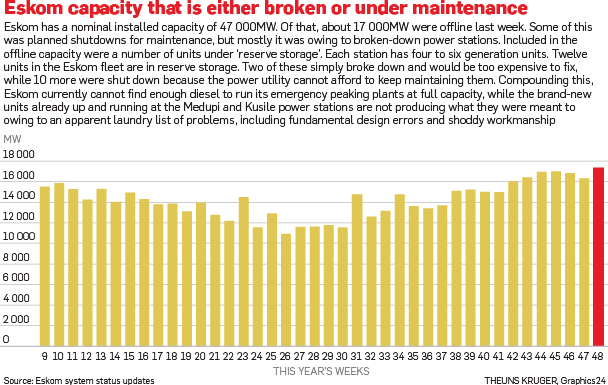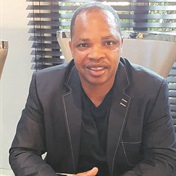
Poor-quality coal, Medupi and Kusile’s design flaws, unplanned repairs are just some of the crises adding to the already broke utility’s woes
A major court battle is looming against suppliers that Eskom blames for shoddy workmanship at Kusile and Medupi power stations, which contributed to last week’s load shedding.
In Eskom’s sights is Mitsubishi Hitachi Power Systems Africa, which two senior Eskom engineers told City Press had contributed to knocking off as much as 1 000 megawatts of the power utility’s generation capacity this week.
They say the design flaws affecting Medupi and Kusile – which are set to cost a combined R345 billion – all relate to work contracted to the Japanese multinational, and resulted in Medupi’s three operational units either shutting down entirely or losing part of their output.
Last week, every single one of South Africa’s 12 largest and most important power stations broke down, according to an internal Eskom document obtained by City Press’ sister publication, Rapport.
Eskom’s plant breakdowns at old stations are reaching catastrophic levels, with a record-breaking 17 371MW – or 38% of Eskom’s total generating capacity – offline.
Twelve coal station units, which provided 2 149MW of power to the grid, are now on “reserve storage” – which effectively means they are mothballed.
Nine were shut down for “economic reasons” and two had to be shut after failures that cannot be fixed right now, Eskom said.
The last time nearly this much Eskom capacity was down was in February 2015, when 15 500MW was offline and a national “electricity emergency” was declared.
The internal Eskom document states that about a quarter of Eskom’s total generating capacity was offline on Wednesday because of unplanned maintenance and repairs.
A further 10% was unavailable because of planned repairs.
At a media briefing last week, Eskom chairperson Jabu Mabuza said all South Africans had to bear responsibility for the latest power crisis.
“Either through our people or our government … but these are problems that we have all caused. There is a role that we all have to play; shareholders, providers of capital, staff, customers. This is the choice of pain we need to take, going forward, to try to put us back in a sustainable way,” he said.
Mabuza has faced a backlash from frustrated South Africans, who refuse to accept that they had anything to do with years of mismanagement and a lack of maintenance at the electricity monopoly.
At the same briefing, Public Enterprises Minister Pravin Gordhan said Eskom was doing its utmost to prevent power cuts over the festive season.
But the internal Eskom document states that, while many of the problems can be fixed by the end of December, it may take until January 2021 to do the necessary repairs.
EXPENSIVE DESIGN BLUNDERS
Two senior engineering sources at Eskom told City Press last week that a reheater temperature control system attached to the boilers at Medupi is failing to control the heat of “super-heated” steam circulating between the boiler and the turbine that produces electricity.
This leads to overheating, which can cause an entire unit to trip and a 480MW loss to the system, said one.
Eskom now has to increasingly “give less fire” and dial down Medupi to prevent it from overheating.
Another major design flaw at Medupi – and, by extension, at the identical Kusile – is the fabric filter that is meant to catch fine ash in the steam funnelled out of the giant smokestacks.
“It is just very inefficient,” said the source.
“It doesn’t catch enough ash, and then it breaks. This leads to high amounts of ash being let out of the station, which puts Eskom in breach of its licence conditions, which include emission limits.
“This also forces Eskom to dial down Medupi while the filter gets fixed.”
The third problem is the grinder that pulverises coal into a fine powder before it is burnt. Each of the 480MW units has a set of grinders feeding it, but they are eroding very quickly, said the source.
This again leads to the unit having to be shut down periodically so the worn-down parts can be replaced.
While all new power stations have flaws that are repaired later, these flaws at Medupi and Kusile are far more extensive than normal, said the source.
“Medupi’s three operational units should produce about 2 150MW (almost 5% of Eskom’s total 47 000MW installed capacity). Recently, we lost 1 000MW of that. That is the extreme case.
“I do not know what it is going to cost to fix, but it will be expensive.”
Eskom’s chief operating officer, Jan Oberholzer, said that the load losses at Medupi and Kusile were “not negligible”, and the question was who would now pay to fix them.
Another engineer said the R1.5 billion Eskom recently allocated to fixing design problems at Medupi and Kusile “will definitely not cover it all” and will be used while Eskom fights its contractors to make them pay instead.
“A big court battle is coming,” he said.
FORENSIC INVESTIGATIONS
Gordhan said last week that forensic investigations showed that original equipment manufacturers at Medupi did a “substandard job”.
He mentioned Mitsubishi Hitachi Power Systems Africa by name three times in the course of the briefing.
“There will be consequences for substandard work and extra costs,” said Gordhan.
Mitsubishi Hitachi Power Systems Africa has, as its BEE partner, the ANC’s investment vehicle, Chancellor House Holdings.
A spokesperson for the company, Nicolas Meyer, told City Press on Saturday that it had a policy “not to comment on these types of issues”.
Eskom chief executive Phakamani Hadebe said the cost of building Medupi had tripled from initial estimates and that there was also evidence of collusion by Eskom employees to inflate costs.
Medupi, situated in Limpopo, has previously seen disputes with Mitsubishi Hitachi Power Systems Africa about shoddy welding on its giant boilers, as well as an apparent mismatch between components that Eskom ordered from different suppliers.
Eskom has begun to admit that both Medupi and Kusile are riddled with fundamental problems that will deny the country the full benefit of their stated capacity of 4 800MW each when completed.
With the rest of Eskom’s fleet of ageing stations suffering record breakdowns, Medupi and Kusile were meant to pull the country out of its electricity crisis.
But now Eskom estimates it will take up to five years to fix them.
A senior Eskom engineer told City Press that fixing any one unit will also mean taking it offline for months.
YET MORE PROBLEMS
Adding to the power shortage is Eskom’s inability to buy enough diesel to run its emergency-peaking plants at full capacity.
Another problem is that the transmission line between South Africa and Mozambique’s Cahora Bassa hydroelectric dam is experiencing difficulties.
Deon Reyneke, the deputy general secretary of trade union Solidarity, also spoke about a lack of basic maintenance at power stations.
This includes the lack of proper monitoring of oil and pressure levels which, when they get too high, cause the stations to shut down automatically to prevent further damage.
Independent power station expert Ted Blom said yet more problems are caused by poor-quality coal.
For example, at Arnot power station in Mpumalanga, an entire 380MW unit had to be shut down in order to remove clinker from the boiler.
“Clinker forms when the aluminium content of the coal is too high,” said Blom.
“It melts and forms on the sides of the boiler. It has to be knocked off with a hammer, but the pipes that are attached to the boiler are very sensitive.”
The unit has to be completely shut down for repairs because the boilers are very hot. It can take a few days for the boiler to cool down sufficiently so that the clinker can be removed.
BROKE
Eskom is borrowing money to service its debts.
In its recent financial results covering the six months to end-September, Eskom reported spending R45 billion on paying back loans and interest on loans, while it had borrowed a new R34 billion to maintain its cash levels.
Municipalities owe Eskom at least R27 billion in unpaid electricity, while residents of Soweto have a debt of R15 billion due to the power utility.
Eskom is now lobbying for a R100 billion government bailout to ease its R420 billion debt burden.
It is not clear what form this might take, and Gordhan said last week that there would be an update early next year.
According to the power utility’s latest application for a 15% tariff increase submitted in October, its maintenance costs for 2018/19 stand at R16.5 billion.
When the current Eskom leadership was appointed this year, their first plan was to convince the Public Investment Corporation (PIC), the Development Bank of Southern Africa and the Industrial Development Corporation to convert R100 billion of their existing Eskom loans into shares.
This semi-privatisation was a long shot because it would be very difficult for the PIC to justify swapping bonds with predetermined interest payments and repayment dates for shares of questionable value and no prospect of dividends any time soon.
The public utility’s profit for the six months was R921 million, compared with R8.8 billion in the comparable same six months last year.




 Publications
Publications
 Partners
Partners









